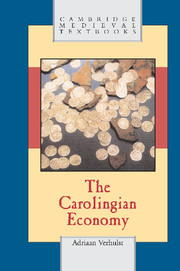7 - Directions of trade
Published online by Cambridge University Press: 05 June 2012
Summary
LOCAL AND INTER-REGIONAL TRADE
The difficulty of differentiating between purely commercial goods and goods to be sold or bought for own consumption was apparently not so great nor so frequent in the transports to local markets, which were representative of local or home trades. These local markets, generally situated in the countryside, were mostly visited by ordinary people who were free of taxes for victuals and utensils bought or sold in small quantities (per deneratas). The transport services of abbeys and churches, also greater in volume, were generally directed to more important markets, situated in urban centres. Except for a fortuitous anecdote in a saint's life, sources are normally silent about what happened in these small markets. Only occasionally are we thus informed of the commodities exchanged. These were wool, flax, finished textiles, iron objects, ploughshares and other agricultural instruments such as metallic sickles, or surpluses from the peasants' own production, mainly grain or seeds, horses and cattle. Normally these markets were held weekly but some grew in importance and developed into an annual fair. This was the case at St Hubert and Bastogne in the Ardennes.
Inter-regional trade, between regions sometimes more than hundreds of kilometres distant from each other, had its stations, annual fairs excepted, in urban centres of different origin, size and importance. Some of them were old Roman civitates, like most Italian cities and many in southern Gaul (Marseilles, Arles, Narbonne, Lyon) and like Rouen, Paris, Amiens, Tournai, Cambrai, Maastricht, Mainz, respectively situated on the Seine, the Somme, the Maas and the Rhine.
- Type
- Chapter
- Information
- The Carolingian Economy , pp. 97 - 114Publisher: Cambridge University PressPrint publication year: 2002

